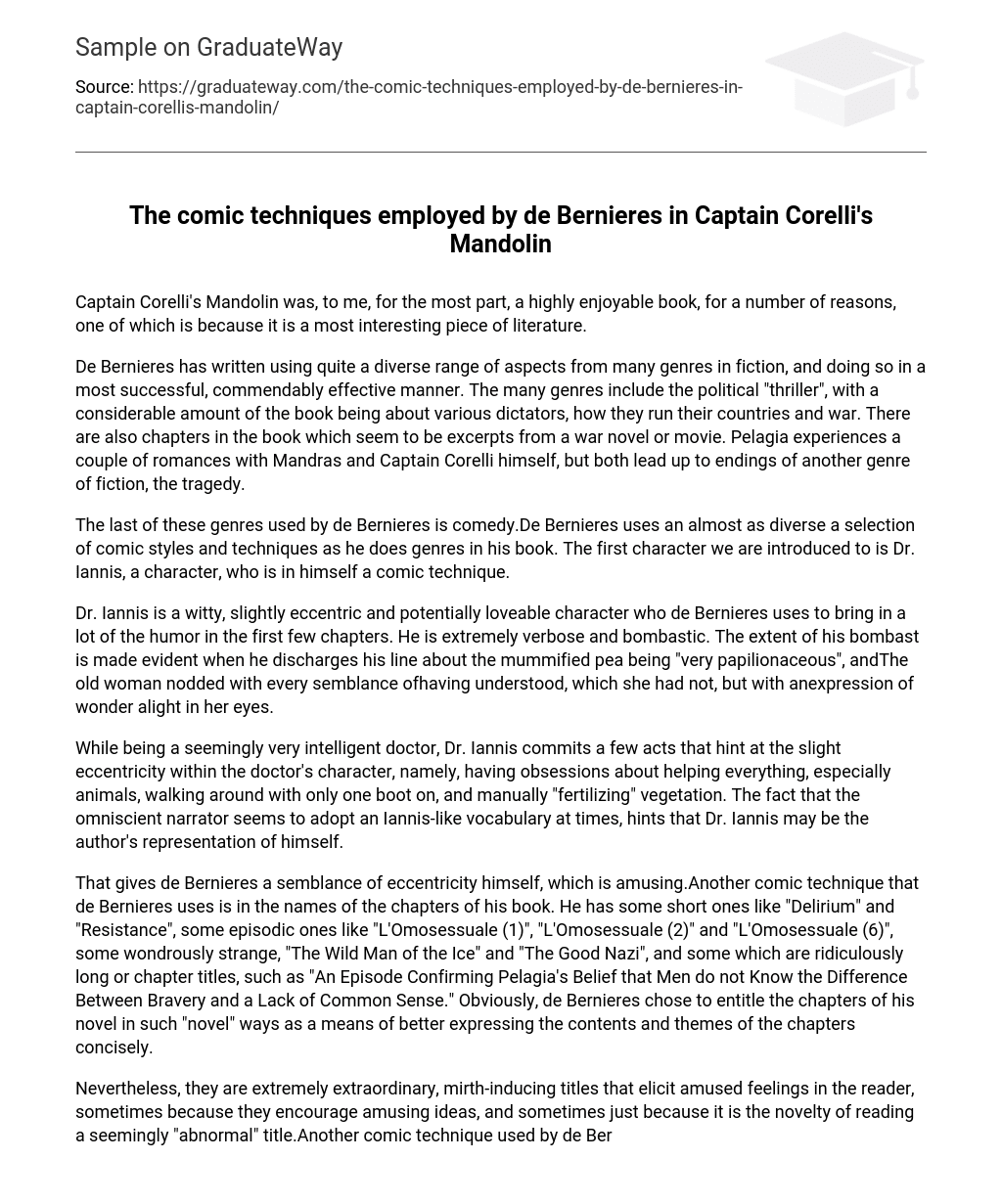Captain Corelli’s Mandolin was, to me, for the most part, a highly enjoyable book, for a number of reasons, one of which is because it is a most interesting piece of literature.
De Bernieres has written using quite a diverse range of aspects from many genres in fiction, and doing so in a most successful, commendably effective manner. The many genres include the political “thriller”, with a considerable amount of the book being about various dictators, how they run their countries and war. There are also chapters in the book which seem to be excerpts from a war novel or movie. Pelagia experiences a couple of romances with Mandras and Captain Corelli himself, but both lead up to endings of another genre of fiction, the tragedy.
The last of these genres used by de Bernieres is comedy.De Bernieres uses an almost as diverse a selection of comic styles and techniques as he does genres in his book. The first character we are introduced to is Dr. Iannis, a character, who is in himself a comic technique.
Dr. Iannis is a witty, slightly eccentric and potentially loveable character who de Bernieres uses to bring in a lot of the humor in the first few chapters. He is extremely verbose and bombastic. The extent of his bombast is made evident when he discharges his line about the mummified pea being “very papilionaceous”, andThe old woman nodded with every semblance ofhaving understood, which she had not, but with anexpression of wonder alight in her eyes.
While being a seemingly very intelligent doctor, Dr. Iannis commits a few acts that hint at the slight eccentricity within the doctor’s character, namely, having obsessions about helping everything, especially animals, walking around with only one boot on, and manually “fertilizing” vegetation. The fact that the omniscient narrator seems to adopt an Iannis-like vocabulary at times, hints that Dr. Iannis may be the author’s representation of himself.
That gives de Bernieres a semblance of eccentricity himself, which is amusing.Another comic technique that de Bernieres uses is in the names of the chapters of his book. He has some short ones like “Delirium” and “Resistance”, some episodic ones like “L’Omosessuale (1)”, “L’Omosessuale (2)” and “L’Omosessuale (6)”, some wondrously strange, “The Wild Man of the Ice” and “The Good Nazi”, and some which are ridiculously long or chapter titles, such as “An Episode Confirming Pelagia’s Belief that Men do not Know the Difference Between Bravery and a Lack of Common Sense.” Obviously, de Bernieres chose to entitle the chapters of his novel in such “novel” ways as a means of better expressing the contents and themes of the chapters concisely.
Nevertheless, they are extremely extraordinary, mirth-inducing titles that elicit amused feelings in the reader, sometimes because they encourage amusing ideas, and sometimes just because it is the novelty of reading a seemingly “abnormal” title.Another comic technique used by de Bernieres is the use of satire. The dictator of renown, Mussolini, was, as I am led to believe, a man to be much feared by the general populace, as indeed most dictators of renown were, in past times. De Bernieres makes him out to be a complete fool that seems to be an unsound choice to be put into the position of running a whole country.
They don’t call me the Unsleeping Dictator for nothing, you don’t catch me asleep all afternoon.He states that he is not like the youngsters of the country who are soft and weak because of the “warm weather”, and he does not sleep all day like they apparently do, but his own self-judgment is contradicted when he later retires to his “siesta-time” after dealing with the cat. He also creates the slogan “War is to Man, what Motherhood is to women,” but immediately talks about engaging in an illicit affair away from his wife. Of course, there is the whole, amusing affair with him, the cat, his revolver and the helmet.
Even though he shows a certain amount of intelligence and cunning in his job, de Bernieres has satirized his character into a fool, with pleasingly funny results. De Bernieres has also cleverly written the chapter, “The Duce”, in entirely “first-person” dialogue, almost like a solo-acting piece of drama, and this effect emphasizes the ridiculousness of de Bernieres’s interpretation of the dictator’s character, making look like he is “full of himself”, pompous and vain, especially when he talks about mirrors and looking for balconies.Apart from these, de Bernieres has also used simple “visual”, sometimes almost slapstick gags and funny situations to add to the comic elements of the book, and these range from, Velisarios lifting the “colossal” weight of the priest, Mandras falling out of a tree and “peppering” his buttocks, and to a certain extent, the accidental “misdirection” of fate on the part of the two soldiers, Francesco and Carlo.All these comic elements, by themselves, are merely shards of de Bernieres’s fascinating book, but, combined with the rest of the book, they only serve to enhance what I can only describe as being an immersing experience.





